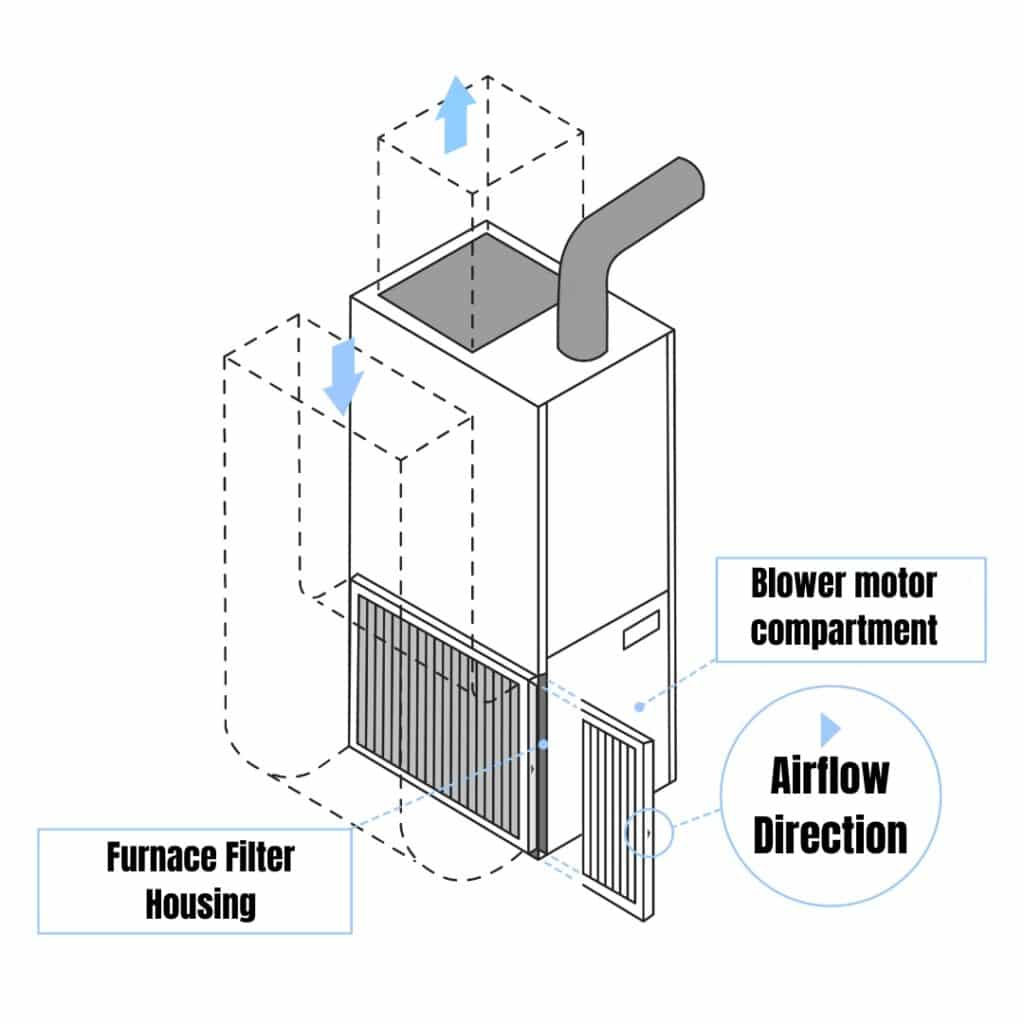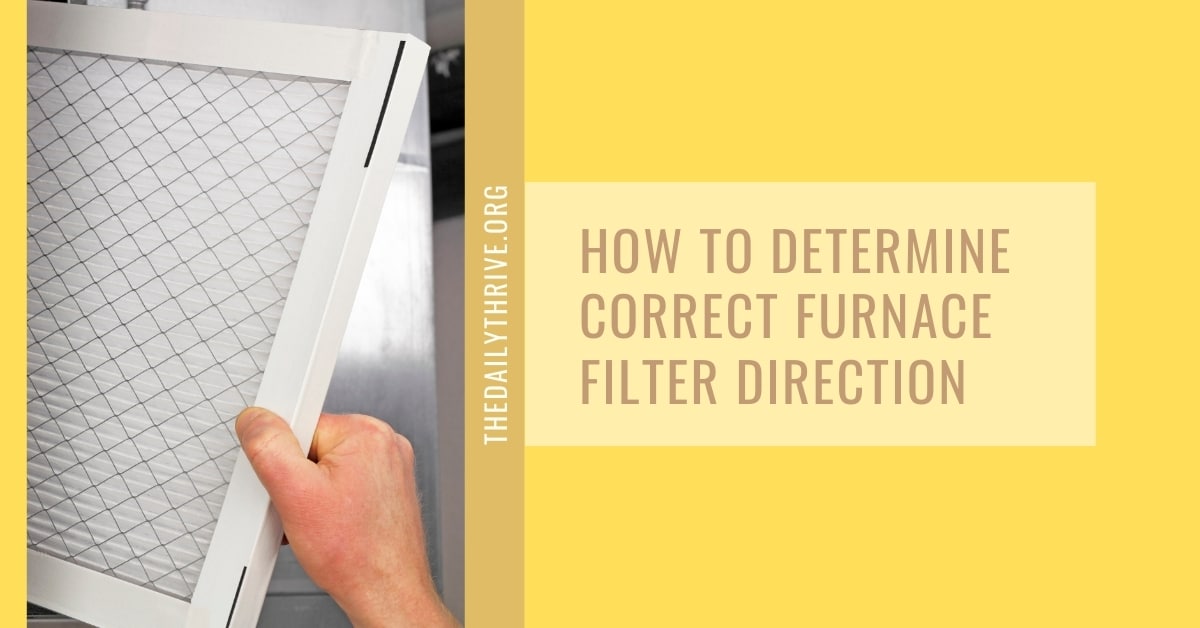Determining the correct direction of a furnace filter is crucial for maintaining the efficiency and longevity of your HVAC system. One of the simplest methods is to observe the orientation of the old filter before removal and install the new one in the same manner. The following tips will serve as a comprehensive guide to assist you in replacing your furnace filter correctly.
A furnace filter is essential for maintaining your heating system and air quality at home. It traps pollutants like dust and dander, preventing them from jamming the furnace or polluting your air. Correctly installing the filter is critical; a backward filter can reduce efficiency, increase utility costs, and strain your furnace.
A backward filter impedes airflow, making the furnace overwork and wear out faster, while also allowing more contaminants to circulate, which can worsen allergies and respiratory issues.
To install a furnace filter properly, locate the arrow on the filter’s frame, which points to the correct airflow direction—towards the furnace and away from the return duct. Ensure this arrow aligns with the air’s path towards the furnace’s blower motor and fan for optimal performance.
Today, I want to shed some light on a common yet overlooked aspect of HVAC maintenance – determining the correct direction for your furnace filter. This simple step is crucial for the health of your furnace and the air quality in your home.
Step-by-Step Guide to Determining Filter Direction
Before you start, ensure you have the correct filter size and type for your furnace. Now, let’s get to the crux of the matter. Most filters have an arrow printed on the side, pointing in the direction of airflow – towards the furnace.
Here’s how you can get it right every time:
- Turn off your furnace.
- Locate the filter compartment.
- Note the arrow on the edge of the filter. This arrow indicates the direction in which air should flow through the filter, which should always be pointing toward the furnace and away from the return duct that carries air back to the furnace.
- Slide the filter in with the arrow pointing in the correct direction.
Where the arrow of the air filter should point towards when replacing furnace filter?
Which way does the arrow go on my furnace filter?
The easiest way in determining which way the furnace filter direction is to refer to the old filter before removing it and installing the new one in the same way. If the old filter has already been removed, you can use these tips as a guide when replacing furnace filter.

The arrow on an air filter for a furnace should point in the direction of the airflow, which means it should point towards the furnace or air handler and away from the return duct that carries the air in need of heating or cooling. In simple terms, the arrow points to where the air is going, not where it’s coming from.
When you’re about to install the new filter, you should find the arrow on the frame of the filter. This arrow is there to ensure that the filter is installed correctly, as filters are designed to trap more particles on one side. If installed backwards, the filter won’t work as efficiently, and it can restrict airflow and cause your system to run less efficiently.
Here’s how to do it:
- Locate the return duct opening or blower compartment.
- Identify the direction that air flows through the ducts (towards the furnace).
- Insert the filter with the arrow on the edge pointing in the direction of the airflow (toward the furnace).
Always ensure the system is off before opening the compartment and changing the filter to avoid injury or damage to the system. If you’re unsure about the process, it’s a good idea to consult with an HVAC professional.
Additionally, your unit’s manual can be an invaluable resource, providing specific filter locations and installation instructions tailored to your system.
The Significance of Correct Filter Direction
When I explain to clients the essence of proper filter orientation, I stress that this is not just a matter of prolonging the life of their furnace but also protecting the quality of their indoor air. The filter is designed to have one side that is more robust to trap larger particles while the other is finer, intended for smaller particles. If reversed, the larger particles can clog the fine mesh, restricting airflow and causing the furnace to work overtime.
This improper installation can cause a domino effect of problems. First, it can strain the blower motor, designed to move air through the filter with minimal resistance. When the filter is backward, the motor must work harder to pull air through, which can lead to increased wear and tear, potentially shortening the motor’s lifespan.
Moreover, when a filter is not installed correctly, it won’t trap contaminants as efficiently. This compromises the air quality and allows dirt and debris to enter the furnace, which can soil the heat exchanger. A dirty heat exchanger operates less efficiently and can even become a fire hazard in extreme cases.
Furthermore, a furnace working harder in the winter months due to a misaligned filter can cause a noticeable spike in energy bills. The system is designed to operate at peak efficiency with the correct filter installation; any deviation can increase energy consumption.
Lastly, it’s not just about the furnace’s performance. The overall comfort of your home is at stake. Inconsistent temperatures, poor air distribution, and even noise can be symptoms of a filter installed in the wrong direction. It may seem trivial, but how a filter is placed in its slot is pivotal in ensuring your home remains comfortable.
As an expert in the field, I cannot overstate the importance of this simple yet crucial step. Proper filter direction is not an option; it is a requirement for a well-maintained, efficient, and safe heating system.
How Often You Should Change Your Air Filter?
Furnace filters should be changed regularly to keep your entire HVAC system running smoothly and to maintain best indoor air quality. How regularly you should replace your furnace filters could depend on the following:
- Type of air filter
- Pets
- Allergies
- Air pollution levels
In general, this is how often changing furnace filters needs to be done:
- 1″ – 2″ filters, replace them every 1 to 3 months
- 3″ – 4″ filters, replace them every 6 to 9 months
- 5′ – 6 filters, replace them every 9 to 12 months
While the above factors affect the frequency of furnace filter replacement, you should visually inspect your filter every month to check for unwanted particle escalation. If the dirty air filter is completely layered with dust and debris, it’s a good idea to replace the air filter even if it hasn’t reached the end of its recommended lifespan.
Changing furnace filters regularly provides great impacts on home comfort and indoor air quality, as well as energy efficiency, and the longevity of your system. Considering how important a furnace filter direction, it is a good idea to ask your HVAC technician to explain the best filter, when to change and how to install.







I am still not sure which way to insert the filter. I’m not sure what the return duct is or what it looks like. My filter is inserted horizontally. The air from my central air conditioner blows upwards through my furnace, so should I be inserting the filter so the arrow is pointing in the same direction (up) or the opposite direction that the air is blowing (down)?
The arrows indicate that air is being pulled INTO the system, so make sure the arrows point INTO the system.